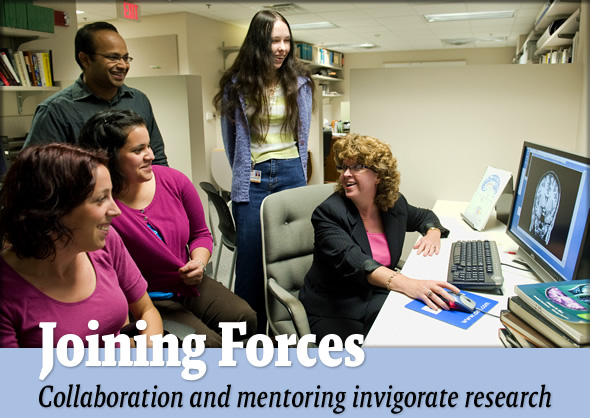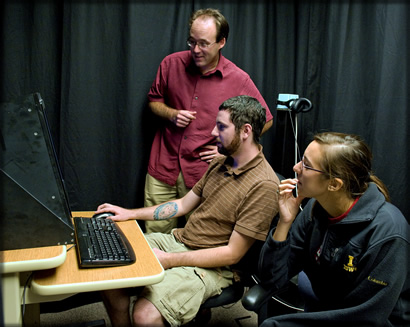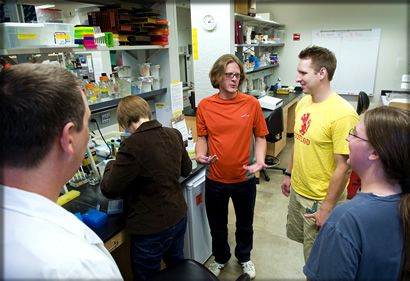-
Page Navigation Links:
- Skip to Site Navigation Links
- Skip to Features

- The University of Iowa
- Spectator
- Monthly News for UI Alumni and Friends

Academic scientists will tell you that theirs is far from a solitary occupation. Relationships with teachers, mentors, and collaborators, many developed and maintained over entire careers, bring new perspectives and insights that have
a profound effect not just on the scientists, but on science itself.
Bob McMurray, assistant professor of psychology in the College of Liberal Arts and Sciences, works in speech perception, word recognition, and language development, collaborating with scientists in speech pathology, linguistics, animal and human learning, and math. When he gets together with his colleague in math to work on a problem, McMurray brings his laptop, while she uses a pad of paper and a pencil.
“She brings a different way of looking at the issues,” McMurray says. “She asks different questions. Plus, she does things with math that I cannot. Joining forces makes for an extremely powerful way to understand.”
Indeed, a major research university like Iowa is all about such relationships. For many young scientists, their career flowers when they find their mentor.
“A teacher passes along information,” McMurray says. “A mentor works to help the student develop skills in finding information, evaluating it, and using it in a successful way. A good mentor understands what the student needs to grow as a scholar and scientist. Sometimes that means throwing a student working on your research project into the deep end of the pool, knowing full well that your project will take longer while the student learns to swim.
“That mentoring relationship is what a university is all about, but it’s hard to put a number on its value. We can count students, hours, grade-point averages, but mentoring is not measurable.”
It may be hard to measure, but the long-term view that mentors must take—often sacrificing their own short-term gains—has definite rewards, says Peg Nopoulos, professor of psychiatry, pediatrics, and neurology in the Roy J. and Lucille A. Carver College of Medicine. She also directs the college’s Doris Duke Clinical Research Fellowship Program, designed to help medical students explore careers in clinical research.
“Mentoring is a big responsibility,” Nopoulos says. “You have someone’s future in your hands. It’s somewhat easier for me because I love my work and I don’t think it’s fair for me to have all the fun. A project might take ten times as long, but I get to share a lot of fun, and in the end, I have someone who’s going to be a better scientist, for me and for science.”
John Logsdon, associate professor of biology in the College of Liberal Arts and Sciences, works in evolutionary molecular genetics. He says that mentoring in the academic sciences is markedly different from many other disciplines.
“In writing, for example, a mentor might provide all the same kinds of advice, guidance, new ways to look at things, perspective—all the good stuff that mentors do,” Logsdon says. “But in the end, your book will have your name on it. In the sciences, the enterprise is collaborative. The product carries all the collaborators’ names. So as a mentor, I have a stake in my students’ achievements, and the student has a responsibility to me to do well. It’s an investment on both sides.”
Like mentoring, these scientists say, collaboration offers growth through changes in viewpoint, new perspectives, and relationships that make for better science.
“The best way to the best science is through other bright people’s eyes and brains,” says Nopoulos, who specializes in Huntington’s disease, a genetic brain disorder, and works with children with cleft lip and palate, collaborating with surgeons, speech pathologists, dentists, child psychologists, pediatricians, pediatric neuropsychologists, and geneticists.
“It can be easy, if you are isolated and working alone, to become biased,” says Nopoulos. “You invest too much in your own ideas. Your passion can blind you. Academic medicine is a life spent having your ideas reviewed and rejected, sometimes accepted. It can be humbling. But I believe that humble pie is the best diet for a scientist.”
“Coming to Iowa awakened me to collaboration,” McMurray says. “At my previous institution, I was in a cognitive science department where we dealt with theory, computational models, and minutiae. I never had contact with clinical science, much less medicine. Coming here, I found a talented set of people working on language disorders and became involved with otolaryngology and education. I was forced to think about how my work affects the real world. I tell people I have learned more in my four years at Iowa than I did in six years of graduate school because I have been confronted by new problems and ideas. It’s been very good.”
—Charles S. Drum
with photos by Kirk Murray
Scientists use more than just pencil and paper to collaborate. Some examples:
Graduate student Brian Krueger, who is completing his PhD in molecular and cellular biology, developed a web site as a tool for scientists to communicate and collaborate. LabSpaces (www.labspaces.net) offers daily news feeds about scientific developments. Members can form groups, publish profiles of their labs to make it easier for collaborators to find partners, join discussion forums, and contribute to or create blogs on the site at no charge.
Thomas Oetting, professor of clinical ophthalmology, created a Facebook group to share cataract surgery techniques with residents in his department through high-quality videos. Oettig also has used Facebook to collaborate on projects with other surgeons in such distant locations as London. For an example, visit www.facebook.com/cataract.surgery?
ref=search&sid=1443251972.
3386063671.1.
Oettig also uses the collaboration site Drop.io to share large files. His book, Cataract Surgery for Greenhorns, is published free of charge on the site MedRounds, a not-for-profit organization whose mission is to provide high-quality medical teaching materials at little or no cost (www.medrounds.org/cataract-surgery-greenhorns/2005/09/title-page.html).

Peg Nopoulos, professor of psychiatry, pediatrics, and neurology (top of page), and Bob McMurray, assistant professor of psychology (above, standing), work with students not only as teachers, but as mentors, helping guide them to careers in science. “It’s a lot more work to mentor a student working on one of my projects and takes a lot more time,” Nopoulos says. “But it is always worth it.”

John Logsdon, associate professor of biology (above, center), talks with students in his lab. The mentoring relationship often is as complex and rewarding as the parenting relationship, Logsdon says, with many similarities. “There are investments made in each other, just like parents and children,” he says. “And there’s certainly tough love.”
© The University of Iowa 2009